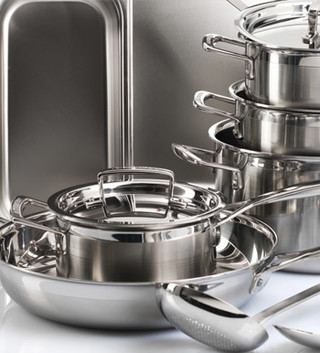AK GGS gives practical advice for cleaning and caring for metal washware
Published at 01.10.2015

Materialization, processing and proper cleaning play an equally important role in achieving perfect washing results and protecting cutlery from corrosion.
The AK GGS (working group commercial dishwashing) has collected the knowledge and experience of experts in the field of tableware and has prepared it in an easily understandable way.
If you want to enjoy your cutlery for as long as possible, you have to pay attention to the materials when buying it. The higher the chrome content of the stainless steel, the better the protection against corrosion.
In addition, a clean surface finish is the key to lasting corrosion resistance.
Sabine Henn, responsible for product conformity at WMF Group GmbH and expert for metal wash ware at AK GGS, explains in the following interview how to recognize real quality and how to properly care for washware made of metal.
Interview with Sabine Henn, responsible for product conformity at WMF Group GmbH and expert for metal washware at AK GGS.
Why is rust-free not just rust-free - what should be taken into account when materializing cutlery?
Stainless steel is defined as steel to which at least 12 percent chromium has been added. The higher the chromium content, the better the stability of the passive layer (chromium oxide layer) to which the corrosion resistance is attributable.
What is meant by a passive layer?
The passive layer serves to protect the stainless steel from corrosion. It consists mainly of chromium oxides. If the passive layer is damaged, e.g. by mechanical action on the surface, it can regenerate in the presence of oxygen.
Which material is particularly suitable for cleaning in commercial dishwashers, why?
Due to the shorter reaction time, the washware in commercial dishwashers is less stressed than in household machines. The frequently used cutlery made of chrome-nickel steel with 18% Cr and 10% Ni is generally considered to be fully dishwasher-safe. In contrast, cutlery made of stainless chrome steel with a chrome content of approx. 13% cannot generally be assumed to be dishwasher safe. For automatic cutlery removal, for which only the magnetizable steels are suitable, it is recommended to use 17 percent chrome steels.
What are the most common misconceptions regarding commercial dishwashing?
Unfavorable washing conditions can cause food residues that have already been removed to be deposited in a finely distributed manner on the wash ware. This occurs in particular when the cleaning solution is too heavily contaminated with food residues or the detergent dosage is too low.
Water may cause residues (staining). Cleaning solution and food residues can remain on the washware if the fresh water rinse is not sufficiently dosed or the washware is regularly sorted too closely into the baskets. Powdered detergents must not be sprinkled over cutlery, as this can lead to stubborn, dark discoloration.
If rust spots and signs of corrosion appear despite correct handling, what are the possible causes?
If rust stains appear despite proper use of the product, it is usually due to extraneous rust, i.e. iron particles that accumulate on the steel surface. Extraneous rust can be caused by the entrainment of rust particles from the water-carrying pipes, by the washing up of non-rust resistant dishes or by the presence of rusting crockery baskets. The use or washing along of e.g. metallic pot scrapers can also lead to rusting of stainless steel parts. If small rust stains have already appeared on the stainless steel, they must be removed immediately. In most cases simple rubbing is sufficient, sometimes a non-abrasive cleaner is necessary. A special form of corrosion is pitting corrosion. Pitting corrosion is usually the result of excessive chloride contamination. With pitting corrosion, a rust-red stain forms, in the center of which a small crater is formed. If this, and above all the cause of the pitting, is not removed, a hole can form in a relatively short time. Pitting corrosion can be caused by:
- Unsuitable steel alloys or improper processing of the steel, defective surface finish
- Unsuitable water with high chloride content
- Long exposure to acidic and / or salty food residues before the dishwashing process
- Underdosing of the detergent
- Malfunction of the water softener (regeneration salt carryover)
How do you recognize a high quality workmanship?
In addition to the material used to make cutlery dishwasher safe, processing plays a decisive role. Basically, the better the surface finish, the more resistant the cutlery is to dishwashing. This applies not only to the front and back of the cutlery, but especially to the cross-sectional areas, such as the areas between the forks, for example. The lower the quality of the material, the higher the demands on the surface treatment. To achieve comparable corrosion resistance, cutlery made of magnetic chrome steels, for example, would have to have a better surface finish than cutlery made of chrome-nickel steels with a higher chrome content. In the case of knife blades and possibly also monobloc knives, the requirement for the best possible surface finish is added to the requirement that the hardening treatment on this material is also optimally carried out.
